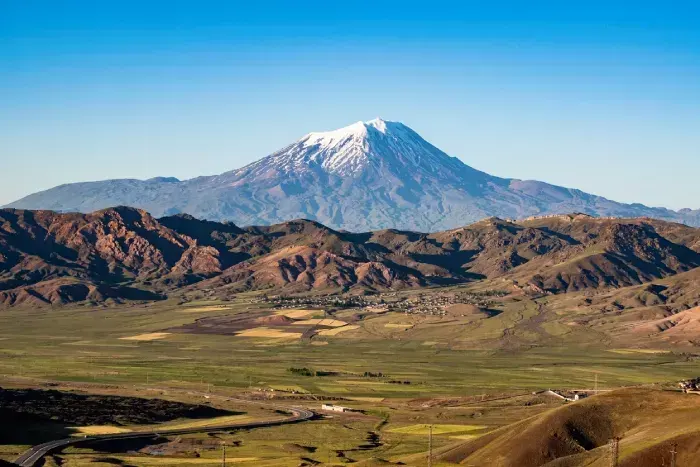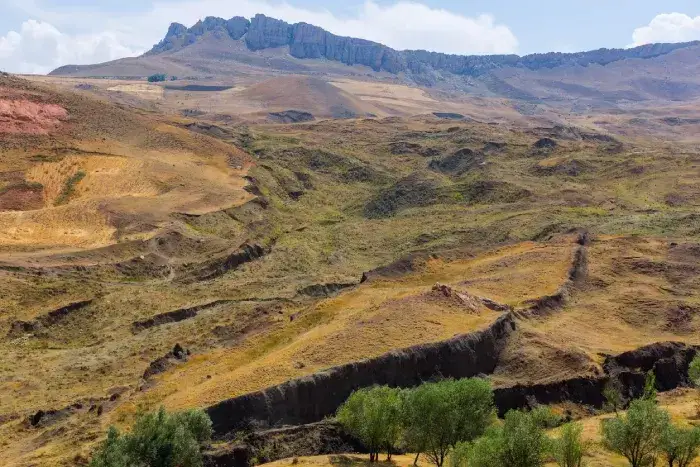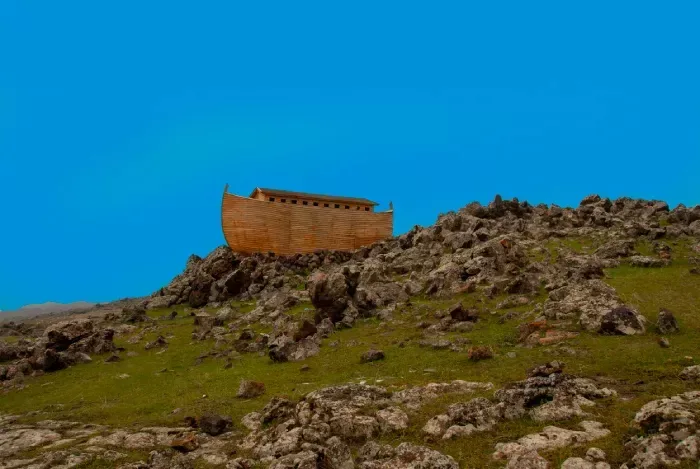Your Ultimate Guide to Noah’s Ark in Turkey
Mentioned in the holy books of the Koran and the Old Testament, it is believed that the Great Flood lasted 150 days as the waters rose after it had rained for 40 days. The land was supposedly sighted one year after the flood.

Hidden near the border between Turkey and Iran is a remarkable geological feature - the Durupinar Formation. The whole world's scientists are amazed by this massive boat-shaped formation, whose dimensions are the exact size as described in the biblical accounts.
Scientific exploration has uncovered staggering evidence at this incredible site. Laboratory tests show soil samples containing clay-like sediment and aquatic substance, 3,500 to 5,000 years old. All these findings combine to form a powerful picture of the prehistoric underwater landscape. The location of the formation is also significant - precisely 18 miles south of Mount Ararat, it matches perfectly with biblical accounts of the ark's resting site.
Sacred to three of the world's major faiths - Christianity, Judaism, and Islam - this amazing site still yields its secrets. The secrets of this ancient vessel are unlocked by historical records, deep local lore, and modern scientific investigation, very possibly one of the most significant discoveries of archaeology.

Historical Records of Noah's Ark in Turkey
Written accounts of Noah's Ark stretch over thousands of years, forming a dense tapestry of historical records. Scientists throughout the ages painstakingly gathered physical evidence and eyewitness accounts of the Genesis flood account.
Ancient texts mentioning Mount Ararat
A few of the earliest descriptions of Noah's Ark are contained in ancient manuscripts. Berossus, a Chaldean priest, in the 3rd century BC wrote of an immense flood and a great boat, the ruins of which were visible in the mountains of Armenia. The Jewish historian Flavius Josephus, in the 1st century AD, also wrote of earlier accounts of remnants of the Ark on Mount Ararat.
Christian church leaders added to this ancient chorus - Epiphanius of Salamis reported ark remnants at Cardyaei, and John Chrysostom pointed to the Armenian mountains as evidence of the great flood.
Early expeditions to the site
Mount Ararat's secrets beckoned 19th-century adventurers. British lawyer James Bryce brought fresh interest after his 1876 expedition yielded wood fragments matching biblical dimensions.
Scientific analysis took center stage with Navarra's 1956 examination of a wood sample. Color, density, and digitization were the aspects studied in laboratory tests that concluded the oak samples were 5,000 years old. The scientific community at large, nevertheless, refused these methods of dating.
Scientists continue to excavate at the Durupinar site today. Analysis of the soil using contemporary technology reveals 3,500- to 5,000-year-old marine deposits, the remains of an ancient flood. Mount Ararat stands as more than an archaeological treasure - every year, thousands of curious minds journey here, drawn by timeless mysteries.

Local Traditions and Beliefs
Eastern Turkish local traditions continue to tell the tale of Noah's Ark. Mount Judi, held sacred by Islamic and early Christian tradition, is believed by many to be the Ark's final resting place. Kurdish oral tradition also honors the mountain's spiritual significance, passing down through the generations tales of the mountain's part in the great flood. Despite the disputed origin of its name, Mount Judi is at the heart of cultural and religious legend as it pertains to Noah's Ark.
Religious significance
Mount Judi is a pilgrimage beacon to three major religions, welcoming Christian, Muslim, and Jewish visitors. The Islamic scriptures specifically name this mountain as the place where the ark came to rest, making it holy ground to the Muslim faithful.
Preservation of culture
Its contemporary guardians conscientiously preserve this sacred heritage:
- Ağrı İbrahim Çeçen University's specialized Cultural Center Board, five distinguished professors strong, oversees ark research under a government mandate
- Armenian tribes maintain age-old spiritual bonds with their sacred mountain
- Recognition looms as geological heritage status beckons, honoring both cultural and scientific worth
The ravages of time bring threats of their own to these revered traditions. Ancient accounts tell of pilgrims and monks who, throughout the centuries, removed visible ark fragments to build their sacred places. Yet the mountain's spiritual magnetism is undiminished, drawing truth-seekers and scientists from distant shores to this remarkable sanctuary.
Impact on Modern Tourism
Sacred heritage meets modern tourism at Turkey's Noah's Ark site, where inquisitive tourists and hundreds of thousands of visitors meet each year. Dogubeyazit district flourishes as the welcoming gateway to this mythic place, its tourist infrastructure blooming alongside economic prospects.
What visitors can see today?
From ancient earth, a magnificent museum complex will bring new life to the Great Flood narrative through digital works of art. Nicely designed spaces await visitors:
- Panoramic promenades and expansive exhibit galleries
- Thoughtfully curated gift center and warm and inviting cafeteria
- Quiet private parkland
- Bewitching digital art exhibitions
- Mentally stimulating visitor center
Weather patterns on the mountain impact visits, with warm seasons from May to October. Seasoned local guides enlighten concealed histories while leading discoverers through these consecrated territories.
Economic returns to the local community
Tourism weaves golden strands into the fabric of the economy of the locals. Local wisdom foresees 1 million visitors passing through these ancient gateways within five years of the museum opening. Opportunities germinate everywhere throughout the Ağrı province - tour operations flourish, accommodation enterprises thrive, and preserving culture creates quality employment.
Above the figures themselves, cultural richness flows between host and guest. Guests are treated to Kurdish hospitality, engage in age-old tradition, and re-spin threads of community unity. Boutique hotels emerge as fresh flowers bloom in springtime, and veteran guides ready themselves for swelling waves of inquiring minds.

Customize Your Dream Vacation!
Get in touch with our local experts for an unforgettable journey.
Plan Your TripFuture of the Noah's Ark Site
Scientific exploration fractures at the Durupinar site as three distinguished institutions join hands to share their expertise. Istanbul Technical University, Andrew University, and Agri Ibrahim Cecen University unite as the Mount Ararat and Noah's Ark Research Team to uncover ancient secrets.
Conservation plans
Holy ground demands holy attention - wisdom in the form of the naming by Turkey's Ministry of Culture and Tourism. Vision takes shape in the form of the created Noah's Ark National Geopark, guardian of precious heritage against the devouring hand of time.
The powers of nature pose stringent tests to this priceless structure. Specially watchful authorities have weaved safety measures into the complex of the area, mindful of erosion threats and its cultural homogeneity. Handcraft professionals will soon apply high-technology geotechnical methods to heal injuries and to shunning deterioration.
Opportunities for research
Science brains chart audacious directions, deploying state-of-the-art technologies to cut through historical shrouds:
- Ground-penetrating radar peels down through surface ground
- Electrical Resistivity Tomography explores the hidden framework
- LiDAR-equipped drones rotate above mountains
- Three-dimensional mapping solidifies every contour
- Core drilling is a whispering of geologic secrets
These serene studies combined with upcoming slow digs vow to unveil this ancient wonder while preserving its secrets for years to come.
Ancient stones and modern science meet at Turkey's sensational Durupinar location. Scientific evidence coincides with ancient depositions spanning millennia, morphing into an increasingly precise picture of this biblical boat's final hiding ground.
Modern eyes peer through windows of technology into the past. The scientific tools - ground-penetrating radar, electrical surveys, and geologic studies - turn over new pages of this old record. But wisdom still flows through local voices, their ancient tales echoing exactly with recorded history.
Holy ground is remodeled as tourism prospers. Tourists of the future will walk down knowledge corridors, their path lit by careful planning and preserved heritage. Mysteries are lurking in mountain shadows, but diligent scholars from top universities work with precision, keeping these secrets for the future.
Here science meets sacred tradition, preservation meets progress, and ancient wisdom encounters modern wonder. The Noah's Ark rock formation stays forever, inviting seekers of truth from distant shores while maintaining its mountain sanctuary. Each season writes new chapters in this amazing tale, as one of history's greatest mysteries continues to reveal its secrets.

FAQs
Q1. Where is Noah's Ark located in Turkey?
Noah’s Ark is believed to be at the Durupınar site, a geological formation in eastern Turkey’s Ağrı Province, about 18 miles (29 km) south of Mount Ararat, near the town of Doğubayazıt.
Q2. How long is Noah's Ark in Turkey?
The Durupınar formation, often linked to Noah’s Ark, is approximately 515 feet (157 meters) long, closely matching the biblical dimensions of 300 cubits as described in ancient texts.
Q3. Can you go see Noah's Ark in Turkey?
Yes! Visitors can explore the Noah’s Ark National Park near Doğubayazıt, Ağrı Province. The site features a visitor center, informational displays, and viewing platforms overlooking the Durupınar formation, believed by some to resemble Noah’s Ark.
Q4. Can you do Noah's Ark in one day?
Absolutely! A visit to the Noah’s Ark site can be done in a few hours. Many travelers combine it with nearby attractions like Ishak Pasha Palace and Mount Ararat’s viewpoints to make the most of their trip.
5. What does Noah’s Ark look like?
The Durupınar formation appears as a large, boat-shaped structure embedded in the earth, measuring roughly the same size as the ark described in biblical texts. While some believe it is a natural rock formation, others see it as compelling evidence of Noah’s Ark’s final resting place.





































